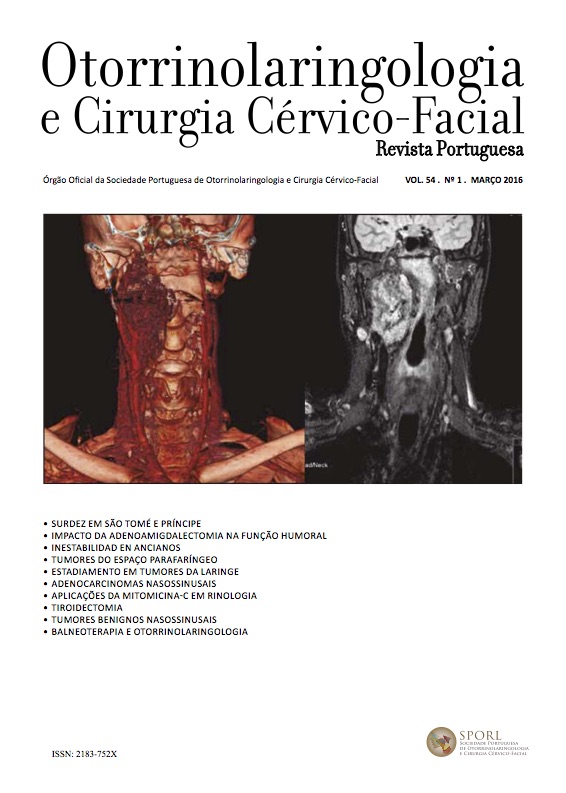Hearing loss in Sao Tome and Principe: 2 years of humanitarian missions
DOI:
https://doi.org/10.34631/sporl.314Keywords:
Hearing Loss, Sensorineural, Malaria, Sao Tome and PrincipeAbstract
Introduction: Hearing is an important sense for the integration of an individual in the community; therefore the identification of factors associated with deafness is important. In this work we reveal the audiometric data verified during 2 years of Otorhinolaryngology humanitarian missions and the identification of possible risk factors for deafness.
Study design - Material and Methods: We evaluated all individuals who have sought audiology consultation in the course of humanitarian missions in Sao Tome and Principe from 2012 to 2014. All patients were observed by an ENT doctor, held earing evaluation by an audiologist and answered a clinical questionnaire in which risk factors were accessed (family history of deafness or co-sanguinity, previous clinical malaria, previous malaria treatment, gestational and peri-partum history, previous ear infections and history of head trauma). Data were processed and analyzed in IBM SPSS 20.0 database.
Results: Of the 721 observed individuals, 77 individuals were excluded because they do not contain audiological registration, obtaining 644 medical records for the study. We found a prevalence of sensorineural hearing loss of 35.7%, conductive deafness of 2.9% and 1.9% mixed. The remaining individuals were normal hearing (59.5%). From the normal hearing individuals, 26% had a unilateral deafness. Of the risk factors analyzed, the history of clinical malaria was the only risk factor that showed more association.
Discussion: Away from the expected values, particularly with regard to the type of deafness encountered, the prevalence of hearing loss in the study sample was high with sensorineural hearing loss as the most prevalent type. According to WHO in developing countries, conductive and mixed deafness were expected to have a higher prevalence Malaria and antimalarial treatment may be contributing to the development of deafness.
Conclusion: Deafness does not always have a single cause. A number of interacting factors may trigger the onset of deafness. In this paper, malaria seemed to be the most significant risk factor in association with sensorineural hearing loss in Sao Tome and Principe. Further studies are being made on the identification of other risk factors.
Downloads
References
Olusanya BO, Neumann KJ, Saunders JE. The global burden of disabling hearing impairment: a call to action. Bull World Health Organ; 2014 p. 367–73.
Plano de apresentação Considerações metodológicas Estrutura da população Dinâmica da população Condições de vida das famílias. 2012;2012.
a Reunião dos Ministros da Saúde dos Pequenos Estados Insulares em Desenvolvimento da Região Africana 16-18 de abril 2013. 2013.
WHO. Country Profiles. World Malaria Report. WHO; 2014. 140 p.
Who N. Media centre Many countries lack capacity to prevent and treat hearing loss. WHO. 2014. p. 12–4.
Lasisi O a, Ayodele JK, Ijaduola GT a. Challenges in management of childhood sensorineural hearing loss in sub-Saharan Africa, Nigeria. Int J Pediatr Otorhinolaryngol. 2006 Apr;70(4):625–9.
Morzaria S, Westerberg BD, Kozak FK. Systematic review of the etiology of bilateral sensorineural hearing loss in children. Int J Pediatr Otorhinolaryngol. 2004 Sep;68(9):1193–8.
Zakzouk SM, Al-Anazy F. Sensorineural hearing impaired children with unknown causes: a comprehensive etiological study. Int J Pediatr Otorhinolaryngol. 2002 May 31;64(1):17–21.
Shet A. Congenital and perinatal infections: throwing new light with an old TORCH. Indian J Pediatr. 2011 Jan;78(1):88–95.
WHO. Immunization Profile - Sao Tome and Principe [Internet]. 2013. p. 1–12. Available from: http://apps.who.int/vaccines/globalsummary/immunization/countryprofileresult.cmf?C=stp
Zhao SZ, Mackenzie IJ. Deafness: malaria as a forgotten cause. Ann Trop Paediatr. 2011 Jan;31(1):1–10.
Schmutzhard J, Kositz CH, Lackner P, Pritz C, Glueckert R, Fischer M, et al. Murine cerebral malaria: histopathology and ICAM 1 immunohistochemistry of the inner ear. Trop Med Int Health. 2011 Aug;16(8):914–22.
Schmutzhard J, Kositz CH, Lackner P, Dietmann A, Fischer M, Glueckert R, et al. Murine malaria is associated with significant hearing impairment. Malar J. 2010 Jan;9:159.
Freeland A, Jones J, Mohammed NK. Sensorineural deafness in Tanzanian children--is ototoxicity a significant cause? A pilot study. Int J Pediatr Otorhinolaryngol. Elsevier Ireland Ltd; 2010 May;74(5):516–9.
Gürkov R, Eshetu T, Miranda IB, Berens-Riha N, Mamo Y, Girma T, et al. Ototoxicity of artemether/lumefantrine in the treatment of falciparum malaria: a randomized trial. Malar J. 2008 Jan;7:179.
Carrara VI, Phyo AP, Nwee P, Soe M, Htoo H, Arunkamomkiri J, et al. Auditory assessment of patients with acute uncomplicated Plasmodium falciparum malaria treated with three-day mefloquine-artesunate on the north-western border of Thailand. Malar J. 2008 Jan;7:233.
Hutagalung R, Htoo H, Nwee PAW, Arunkamomkiri J, Zwang J, Nosten F. A CASE-CONTROL AUDITORY EVALUATION OF PATIENTS TREATED WITH. Trop Med. 2006;74(2):211–4.
Roche RJ, Silamut K, Pukrittayakamee S, Looareesuwan S, Molunto P, Boonamrung S, et al. Quinine induces reversible high-tone hearing loss. Br J Clin Pharmacol. 1990 Jun;29(6):780–2.
Burch-Sims GP, Matlock VR. Hearing loss and auditory function in sickle cell disease. J Commun Disord. 2005;38(4):321–9.
Mgbor N, Emodi I. Sensorineural hearing loss in Nigerian children with sickle cell disease. Int J Pediatr Otorhinolaryngol. 2004 Nov;68(11):1413–6.
Kuzniewicz MW, Wickremasinghe a. C, Wu YW, McCulloch CE, Walsh EM, Wi S, et al. Incidence, Etiology, and Outcomes of Hazardous Hyperbilirubinemia in Newborns. Pediatrics. 2014;4–11.
Worley G, Erwin CW, Goldstein RF, Provenzale JM, Ware RE. Development of SensorineuraI Hearing Loss After Neonatal Hyperbilirubinemia : A Case Report with Brain Magnetic Imaging Delaved. Dev Med Child Neurol. 1996;38:271–7.






